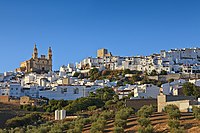اولویرا
Olvera | |
|---|---|
 Olvera at sunset | |
 Location of Olvera | |
| موختصاتلار: 36°56′4″N 5°15′35″W / 36.93444°N 5.25972°Wموختصات: 36°56′4″N 5°15′35″W / 36.93444°N 5.25972°W | |
| Autonomous community | Andalusia |
| ایسپانیا اوستانلاری | کادیس اوستانی |
| Comarca | Sierra de Cádiz |
| ایداره | |
| • بلدیه باشچیسی | Francisco Parraga Rodríguez (PSOE) |
| اراضی | |
| • جمع | ۱۹۴ km2 (۷۵ sq mi) |
| • توپراق | ۱۹۴ km2 (۷۵ sq mi) |
| • سو | ۰٫۰۰ km2 (۰�۰۰ sq mi) |
| جمعیت (2005) | |
| • جمع | ۸٬۵۸۵ |
| • سیخلیق | ۴۴/km2 (۱۱۰/sq mi) |
| ساعات قورشاغی | یوتیسی +1 (CET) |
| • یای (DST) | یوتیسی +2 (CEST) |
| وئب سایت | <ref>olvera.es |
اولویرا (ایسپانجا: Olvera) ایسپانیادا بیر یاشاییش منطقهسیدیر بۇ شهرین مساحتی ۱۹۴ کیلومتر موربّع دیر. سوْن نۆفوس تخمینلرینه گؤره ۸۵۸۵ نفر دیر.
گؤرونتولر
[دَییشدیر]بیرده باخ
[دَییشدیر]قایناقلار
[دَییشدیر]ایسپانیا ویکیپدیاسینین ایشلدنلری طرفیندن یارانمیش«Olvera»، مقالهسیندن گؤتورولوبدور.( ۷ مارس ۲۰۱۸ تاریخینده یوْخلانیلیبدیر).
| بو شهرلر ایله باغلی مقاله، بیر قارالاما مقاله دیر. بونو گئنیشلندیرمکله ویکیپدیایا کؤمک ائده بیلرسینیز. |
| Historical population | ||
|---|---|---|
| Year | Pop. | ±% |
| 1999 | ۸٬۸۱۸ | — |
| 2000 | ۸٬۶۸۵ | −1.5% |
| 2001 | ۸٬۵۳۸ | −1.7% |
| 2002 | ۸٬۶۱۴ | +0.9% |
| 2003 | ۸٬۵۸۴ | −0.3% |
| 2004 | ۸٬۵۴۹ | −0.4% |
| 2005 | ۸٬۵۸۵ | +0.4% |
| Source: INE (Spain) | ||
There is a lack of specific data and studies into the true origin of the town. This means it is of conjecture to historians, some thinking that the present city was an establishment named Caricus, about the time of the Celts. Professor Ramos Santana posits that the legendary Cenosia, the original name of Olvera, located near the present city centre, was known as Vallehermoso (beautiful valley), existing at the time of the Visigoths. In this area of the mountain range of Sierra de Lijar are numerous Roman camps and remains. The archaeologist Lorenzo Perdigones' report (1986) shows the existence of a Roman establishment in the area, dated the end of 3rd century B.C. Indeed, the foundations of the city castle were found to be Roman, during the removal of some of the rubble. The original name of Olvera could be "Ilipa", (established by geographically adjusting in a map of Roman Spain, published in 1879, between Morón and Ronda). Hippa and Hippo Nova are likely names of the original village. But the first demonstrably reliable origin of Olvera is within Muslim documentation, in the mid 12th Century, when it is chronicled as an outpost in the mountains called "WUBIRA" or "URIWILA" (year 1327) when king اوْنبیرینجی آلفونسو wrested it from the Arabs. As part of the Christian conquest plans emanting from Seville, Olvera formed part of the advance strategy towards the Straits of Gibraltar to prevent the reinsurgence of Muslims. In one first expedition the Christians lost the banner of Seville that flew in Olvera castle. After the negotiations that followed the surrender of the town, Ibrahim-ibn-Utmain secured concessions, in respect of the Moors of Olvera, that each one of the inhabitants could keep their houses and goods. The village was repopulated through a decree, a 'Letter of Population', issued on the 1 of August 1327, in which all criminals and debtors could, and had to, remain a year within the borders of Nazarí (Granada province?) in order that their debt to society be removed. This new acquisition for the King of Castilla was named Olivera to commemorate the sea of olive trees that surround it. With time, the "i" was phonetically lost giving rise to the present name. In the middle of the 14th century the town passed to Don Alfonso Perez de Guzman. It is known that in 1395 Perez de Guzman arranged the marriage of his daughter with the son of the Muslim, Zunigaga. Olvera was host to a detachment of Napoleonic troops, who were constantly harassed by the activities of guerrillas from the town until the French retreated in 1812. The years of the dictatorship of Franco provided opportunities for the Olvereños, who benefited from the building of the Jerez-Almargen railroad which terminated within the municipality. The project was never finished. This is now a well known "Via Verde" - a nature walk of some 40 km. In 1983 Olvera was declared “A Protected Area of Artistic and Historical Importance”. At the present time, Olvera is dedicated to agriculture, forestry and animal husbandry, activities that are complemented by the tourist activities and the cooperatives.starting in Olvera and reaching Puerto Serrano. Nicholas de Ribera, El Viejo, 'the old one', was born in Olvera in 1487 and took part in the conquest of Peru. In 1535 he was named the first mayor of Lima.








































